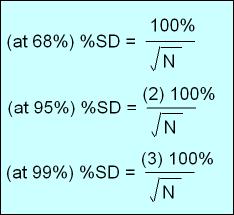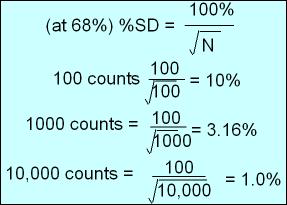- This can be applied to the number of counts acquired from a well counter or uptake probe
- As you increase the number of counts acquired you reduce the percent error or the %SD decreases
- This tells us that the more counts you have the less error occurs


- The formula above uses only 1 SD
- As a general rule, it can be stated that you always want to acquire at least 10,000 counts in any sample. The reason for this is that at 1SD there is only a 1% chance of error. If you apply 3SD then the there would be a 3% chance of error.
- In addition, you should note how your %SD decreases as you increase in the number of counts in a sample
- What is the percent error in a thyroid uptake that has 254,000 counts at 3SDs?
- What is the percent of error in the thyroid uptake that has 25,000 counts at 3SDs?
- Of the two mentioned, which has the least amount of error?